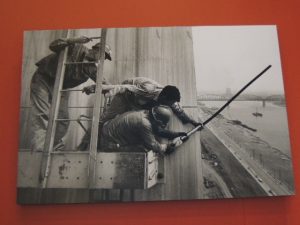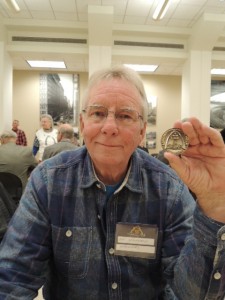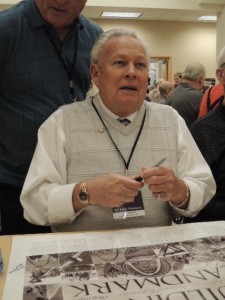
By TIM ROWDEN
Editor
The men who built the Gateway Arch – iron workers, boilermakers, elevator constructors, sheet metal workers, concrete masons and electricians – now in their 70s, 80s and even 90s, were feted like Hollywood celebrities last week at a “Meet the Builders” event at the Missouri History Museum in Forest Park as the region celebrated the 50th anniversary of the iconic landmark’s completion.
The museum hosted the anniversary events while the CityArchRiver construction is under way at the Arch grounds.
For most of the men gathered at the History Museum – some staring at photos which adorned the walls of their younger selves working on the Arch project – it was just a job. It wasn’t until it was completed that they came to appreciate how special their work had been.
(Get historic Labor stories like this delivered straight to your inbox with our free weekly email newsletter!)
‘THOSE GUYS WERE SURGEONS’

“There was a seven-man crew on the south derrick, and I was the weakest link in that crew because I was 20 years old,” joked Ted Imbierowicz, 70, an Iron Worker with Local 396. “I was petrified.
“It was quite an experience,” he said, both for the astounding heights and the skilled craftsmanship he witnessed on the job.
“I found out how really good those guys were,” Imbierowicz said. “Those guys were the doctors and the surgeons of that project. There was always something new and unexpected because it was new. There were always changes or something that didn’t work right.”
Even the equipment was astounding Imbierowicz said. The tools were too heavy for him to pick up.
The safety meetings, he said, consisted of project managers telling the men to “be safe.”
DERRING DO

Don Horton has proof of that. One of the photos on the wall shows him leaning over a ledge hundreds of feet in the air, tightening a bolt with a wrench strapped onto a cheater pipe. He’s not wearing a harness, just holding on to a nearby ladder wrung.
Horton was 25 at the time and had been working as an iron worker with Local 396 since he was 16.
No one thought of the job as anything special, he said, because most of the men had more pressing concerns.
“We were just trying to keep the wolf from the door,” he said, referring to the need to earn a steady paycheck to feed his family.
But what they built was something special, something that would become the symbol of St. Louis, and a tourist attraction for decades to come.
‘THANK YOU’
Kelly Hutchison, who works at the Arch and was busy collecting autographs, said her grandfather, the late George Crawford was one of the men who worked on the project.
“I’ve been thanking these men for my job as I go around,” she said.

‘IT WAS A JOB’
Art Setchfield, an Elevator Constructor with Local 3, was 18 when he started work on the project. He is quick to point out that his crew as not responsible for the tiny capsules visitors cram into to ride to the top of the monument. His crew built the maintenance elevators, which go up about 400 feet inside the 630-foot monument.
“It was a job,” he said simply. “I made $2.33 an hour working as an apprentice. The journeymen were making $4.66.
Setchfield still has a commemorative coin workers were given when the project was finished, and a well-worn square of stainless steel he keeps in his pocket.
‘IT WAS SOMETHING SPECIAL’
Bruce Izatt, an iron worker, is 69. He was 18 when he worked on the project. He has a photo of one of his crewmates, John Wagner, getting a haircut atop one of the rising legs of the Arch. He had complained that he’d gotten a bad haircut earlier and Bill Walsh, a barber, offered to trim him up.
“The Post-Dispatch came out and did a story,” he said. “They said it was the highest haircut in the city of St. Louis. I think we were up 480 feet when we did that.”
Like the other Arch builders, Izatt didn’t think he was doing anything special.
“It was just a job,” he said. “It was an interesting job, but I was just trying to feed my family and keep on working.”
Today, he knows different.
“It was something special,” he said. “A lot of the things we did, we’d never do again.”
Tom McNeil, business manager for Iron Workers Local 396, is proud of his local’s connection to the monument.

“Whenever we go out of town to other locals and to conferences that’s all they talk about, how amazing the Arch is when they drive into downtown. It’s right up there with the Statue of Liberty and the Empire State Building.”
‘BABY ARCH’
Boilermaker Local 659 members at Pittsburgh-Des Moines (PDM) steel fabricating plant in Warren, PA, constructed about 80 percent of the Arch sections. The base sections were constructed at a separate PDM facility at Neville Island, PA.
The sections were shipped by rail to St. Louis, where ironworkers and other craftsmen erected the monument.
A miniature version stands in front of the Warren County Chamber of Business and Industry.
The Committee of Retired Boilermakers, based in Warren, PA, recently initiated a campaign for recognition of the men who worked for the PDM plant and is soliciting donors for a new project to fabricate and erect a scale model replica (“Baby Arch”) at the Warren County PA Visitors Center. For more information, visit www.babyarch.org.

